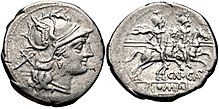
The gens Calpurnia was a plebeian family at ancient Rome, which first appears in history during the third century BC. The first of the gens to obtain the consulship was Gaius Calpurnius Piso in 180 BC, but from this time their consulships were very frequent, and the family of the Pisones became one of the most illustrious in the Roman state. Two important pieces of Republican legislation, the lex Calpurnia of 149 BC and lex Acilia Calpurnia of 67 BC were passed by members of the gens.[1]
The Calpurnii claimed descent from Calpus, the son of Numa Pompilius, the second King of Rome, and accordingly the head of Numa is found on some of the coins of this gens.[2][3][4][5]
The principal praenomina of the Calpurnii were Lucius, Gaius, Marcus, and Gnaeus. Publius was not a regular name of the Calpurnia gens during the Republic, but was used by the Calpurnii Lanarii.[6]
The family-names of the Calpurnii under the Republic were Bestia, Bibulus, Flamma, Lanarius, and Piso.
Piso was the name of the greatest family of the Calpurnia gens. Like many other cognomina, this name is connected with agriculture, and comes from the verb pisere or pinsere, which refers to the pounding or grinding of corn. The family first rose from obscurity during the Second Punic War, and from that time it became one of the most distinguished in the Roman state. It preserved its celebrity under the empire, and during the first century was second to the imperial family alone. Many of the Pisones bore this cognomen alone, but others bore the agnomina Caesoninus and Frugi.[1]
Of the other surnames of the Republican Calpurnii, Bestia refers to a "beast", "an animal without reason". Bibulus translates as "fond of drinking", or "thirsty", while Flamma refers to a flame.[7]

